– …. . — — .-. … . -.-. — -.. . — .- .-. — — -. .. … …. .- -. –. .. -. –. .. -. – …. . .-. . –..– -… ..- – – .- .-.. -.- .- -… — ..- – .- -. — – …. . .-. .-.. . … … — -. .. -. .–. .- – .. . -. -.-. . .- -. -.. ..-. .-. ..- … – .-. .- – .. — -.
OK, seriously though, the rest of the post will be in plain English 😉
I’ve discussed the problems facing the “Morse Code” Maroon with Christine Williams and Boomer. Both often make a reference of Edward Noga. As you know, I’ve been treating the Morse Code’s mouth rot with Kanamycin. From Christine, the dosage of Kanamycin for fish is “50-100 mg/liter every 3 days for 3 treatments with a 50% WC before each”.
As you know, I’m using Kanamycin powder from National Fish Pharmacy (www.fishyfarmacy.com). Both Christine and Boomer have suggested that the dosage on Kanamycin may be “low” compared to that recommended by Noga. So I sat and “did the math”.
I’m using their consumer packaged Kanamycin, which is called “Kana Pro”. From their website, the dosage is 1/4 teaspon per 20 gallons of water. Treat every 24 hours with a 25% water change before each treatment. Treat for 10 days. For tuberculosis, use for up to 30 days.
The entire package of Kana Pro is 20 grams, and treats 640 gallons at their dosage rate. Per their dosage, that works out to 1 gram (1000 mg) treating 32 gallons of water (121 Liters). This works out to roughly 8.25 mg per L per day. If I went to dosing every third day at that level, it amounts to roughly 25 mg per L. This is basically half of Noga’s minimum dosage. Of course, I simply also need to mention that other experts give dosages lower than Noga, i.e. more in the range of 20 mg/L to 50 mg/L according to the sources that Boomer cited, but Boomer was quick to add that often times, the dosage for a medication in saltwater can be as much as twice that in freshwater. That could easily account for a disparity between Noga and the other references, specifically if Noga is talking marine and the others were talking fresh!
So far, at best I was only at the absolute bare minimum therapeutic level for Kanamycin based on the dosage. But then things took another bizzare turn. Boomer noticed it, credit where credit is due. National Fish Pharmacy sells both Kana-Pro (hobbyist packaged product) and bulk Kanamycin Sulfate powder. 20 Grams of Kana Pro sells for $14. 25 grams of bulk Kanamycin Sulfate sells for $35. The net result – Kana Pro sells for about 50% of what the bulk product sells for. WHY?! Even more curious, the package of Kana Pro says right on it “Pure kanamycin sulfate powder – no inert ingredients added”.
While I have not found the time to contact National Fish Pharmacy to ask about this very peculiar discrepency, it is certainly suggestive that the hobbyist-packaged Kana Pro cannot be the same thing as the Kanamycin Sulfate that our published experts are referring to when they talk about dosages. At best, it may be that the bulk Kanamycin Sulfate is a higher GRADE and thus more expensive. At worst, the Kana Pro could very well be a diluted form, perhaps mandated as such by the FDA for “home use” (this is purported to be a FDA-Approved product). In the worse case scenario, could it be that the “Kana Pro” is diluted by 50% or more (would clearly justify costing half as much!)? The real implication, when you follow it through, is that if Kana Pro is 50% or less of the active ingredient, then the labeled dosage might not be just “half” of Noga’s minimum dosage, but 25% or lower of the minimum suggested dosage by Noga.
And we wonder why medicating fish is a “complicated” issue! Well, after 3 doses following the instructions, I had seen no results. Once Christine, Boomer and I had these conversations, I took it upon myself to immediately DOUBLE the volume of dosage of Kana Pro I was using. Based on all the information I had at hand, it seemed to be a safe and likely necessary step.
On Tuesday, I took another step – I swabbed the fish. The plan was to send a sample to Christine for culturing / identification. Obviously, if I we can figure out what exactly is going on, we have a better chance to treat it. If nothing else, we may be able to put a real label on these photos and say “here’s a known case of X infecting a Maroon Clownfish”. Of course, I missed the post office, so the package went out Wed and should arrive Friday. Obviously, answers will not be immediate.
It is now Thursday night, and for the past 3 nights I’ve been using the doubled dose of Kana Pro. The verdict? Let the pictures tell you:
It is pretty clear to me that Kanamycin, even at the doubled dosage, is having NO affect on this infection. My plan now has been to abandon this (as I’ve used almost an entire package with no results now). Around 8:00 PM I placed a large back of fresh carbon in the filter. I’ll followup with a larger partial water change as well, and probably by midnight, I’ll be using a different medication. Looking at what I have on hand, and what has more often succeeded than failed, it will probably be Maracyn SW (Erythromycin). I believe I also have Maracyn Two SW (Monocycline) running around. I believe I can even tag-team these two medications by using them together, hitting both gram-positive and gram-negative bacteria respectively. Given that Kanamycin treats gram-negative bacteria primarily, the use of Monocycline with Erythromycin may be unnecessary, but at this point, what’s a guy to do?
- About The Lightning Project
- Inventory of F1 PNG Lightning and White Stripe Maroon Clownfish
- F1 PNG Lightning Maroon Clownfish, BZLM1
- F1 PNG Lightning Maroon Clownfish, BZLM2
- F1 PNG Lightning Maroon Clownfish, FW1
- F1 PNG Lightning Maroon Clownfish, LM10
- F1 PNG Lightning Maroon Clownfish, LM11
- F1 PNG Lightning Maroon Clownfish, LM12
- F1 PNG Lightning Maroon Clownfish, LM13
- F1 PNG Lightning Maroon Clownfish, LM14
- F1 PNG Lightning Maroon Clownfish, LM15
- F1 PNG Lightning Maroon Clownfish, LM16
- F1 PNG Lightning Maroon Clownfish, LM17
- F1 PNG Lightning Maroon Clownfish, LM18
- F1 PNG Lightning Maroon Clownfish, LM19
- F1 PNG Lightning Maroon Clownfish, LM20
- F1 PNG Lightning Maroon Clownfish, LM3
- F1 PNG Lightning Maroon Clownfish, LM4
- F1 PNG Lightning Maroon Clownfish, LM5
- F1 PNG Lightning Maroon Clownfish, LM6
- F1 PNG Lightning Maroon Clownfish, LM7
- F1 PNG Lightning Maroon Clownfish, LM8
- F1 PNG Lightning Maroon Clownfish, LM9
- F1 PNG Lightning Maroon Clownfish, MD1
- F1 PNG Lightning Maroon Clownfish, MWP3
- F1 PNG Lightning Maroon Clownfish, WS17
- F1 PNG Lightning Maroon, EC1
- F1 PNG Lightning Maroon, GL1
- F1 PNG White Stripe Maroon Clownfish, BZWS1
- F1 PNG White Stripe Maroon Clownfish, BZWS2
- F1 PNG White Stripe Maroon Clownfish, BZWS3
- F1 PNG White Stripe Maroon Clownfish, WS10
- F1 PNG White Stripe Maroon Clownfish, WS11
- F1 PNG White Stripe Maroon Clownfish, WS12
- F1 PNG White Stripe Maroon Clownfish, WS13
- F1 PNG White Stripe Maroon Clownfish, WS14
- F1 PNG White Stripe Maroon Clownfish, WS15
- F1 PNG White Stripe Maroon Clownfish, WS16
- F1 PNG White Stripe Maroon Clownfish, WS4
- F1 PNG White Stripe Maroon Clownfish, WS5
- F1 PNG White Stripe Maroon Clownfish, WS6
- F1 PNG White Stripe Maroon Clownfish, WS7
- F1 PNG White Stripe Maroon Clownfish, WS8
- F1 PNG White Stripe Maroon Clownfish, WS9
- F1 PNG White Stripe Maroon, EC2
- F1 PNG White Stripe Maroon, FW2
- F1 PNG White Stripe Maroon, GL2
- F1 PNG White Stripe Maroon, MD2
- Lightning Breeding Directive
- Lightning Maroon Clownfish Links
- Home
- About The Lightning Project
- Inventory of F1 PNG Lightning and White Stripe Maroon Clownfish
- F1 PNG Lightning Maroon Clownfish, BZLM1
- F1 PNG Lightning Maroon Clownfish, BZLM2
- F1 PNG Lightning Maroon Clownfish, FW1
- F1 PNG Lightning Maroon Clownfish, LM10
- F1 PNG Lightning Maroon Clownfish, LM11
- F1 PNG Lightning Maroon Clownfish, LM12
- F1 PNG Lightning Maroon Clownfish, LM13
- F1 PNG Lightning Maroon Clownfish, LM14
- F1 PNG Lightning Maroon Clownfish, LM15
- F1 PNG Lightning Maroon Clownfish, LM16
- F1 PNG Lightning Maroon Clownfish, LM17
- F1 PNG Lightning Maroon Clownfish, LM18
- F1 PNG Lightning Maroon Clownfish, LM19
- F1 PNG Lightning Maroon Clownfish, LM20
- F1 PNG Lightning Maroon Clownfish, LM3
- F1 PNG Lightning Maroon Clownfish, LM4
- F1 PNG Lightning Maroon Clownfish, LM5
- F1 PNG Lightning Maroon Clownfish, LM6
- F1 PNG Lightning Maroon Clownfish, LM7
- F1 PNG Lightning Maroon Clownfish, LM8
- F1 PNG Lightning Maroon Clownfish, LM9
- F1 PNG Lightning Maroon Clownfish, MD1
- F1 PNG Lightning Maroon Clownfish, MWP3
- F1 PNG Lightning Maroon Clownfish, WS17
- F1 PNG Lightning Maroon, EC1
- F1 PNG Lightning Maroon, GL1
- F1 PNG White Stripe Maroon Clownfish, BZWS1
- F1 PNG White Stripe Maroon Clownfish, BZWS2
- F1 PNG White Stripe Maroon Clownfish, BZWS3
- F1 PNG White Stripe Maroon Clownfish, WS10
- F1 PNG White Stripe Maroon Clownfish, WS11
- F1 PNG White Stripe Maroon Clownfish, WS12
- F1 PNG White Stripe Maroon Clownfish, WS13
- F1 PNG White Stripe Maroon Clownfish, WS14
- F1 PNG White Stripe Maroon Clownfish, WS15
- F1 PNG White Stripe Maroon Clownfish, WS16
- F1 PNG White Stripe Maroon Clownfish, WS4
- F1 PNG White Stripe Maroon Clownfish, WS5
- F1 PNG White Stripe Maroon Clownfish, WS6
- F1 PNG White Stripe Maroon Clownfish, WS7
- F1 PNG White Stripe Maroon Clownfish, WS8
- F1 PNG White Stripe Maroon Clownfish, WS9
- F1 PNG White Stripe Maroon, EC2
- F1 PNG White Stripe Maroon, FW2
- F1 PNG White Stripe Maroon, GL2
- F1 PNG White Stripe Maroon, MD2
- Lightning Breeding Directive
- Lightning Maroon Clownfish Links
…is that life has a way of giving you a nice smack in the face, aka a “reality check”. The old phrase “don’t count your [clownfish] before they hatch” seems to apply here.
I alluded to it at the end of my last post. Yes, the “Morse Code” Maroon is having issues…it showed signs almost immediately and 24 hours in I made the decision to move it into another empty tank and begin treatment. Not having the benefit of a laboratory, nor the luxury of a vet, I was forced to make a rapid guess and hope I was right. Time this weekend has been nonexistent (a visit to see my best friend who lives in DC, then a car was hit on the street, and a family member was put under and had surgery today, doing well thank you) but I’ve at least been staying on feeding and treatment regimes. Here’s where the Morse Code Maroon went…

So what exactly is wrong with the Morse Code Maroon? I’m not 100% sure, but I did notice what looked like “rawness” on the mouth when the fish was released. The pictures from that evening don’t really show it. 24 hours in, the mouth had turned gray and was showing signs of erosion, and so, the fish was moved. Here’s what I was looking at.
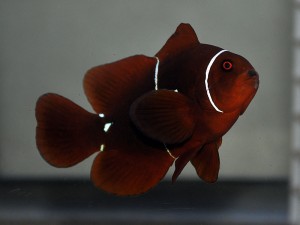

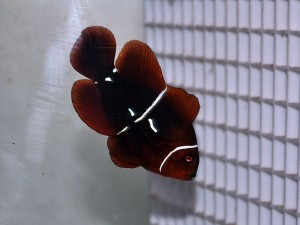
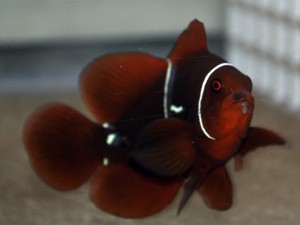
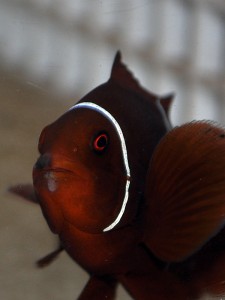
For the moment, I’ll just use the generic term “Mouth Rot”, which really describes only a symptom, something that could be caused by a myriad of possible vectors. As I stated earlier, not having a lot of time to diagnose and collaborate on this one, I went with Kanamycin, which I had on hand from the “lost shipment” when I was trying to switch antibiotics on the original female PNG Maroon. As an “shotgun approach” antibiotic, it was the recommendation of at least a couple of the project advisors earlier on. I figured, why not? Christine Williams and Boomer both definitely preferred it over my personal default, Erythromycin. Seems that Kanamycin is not that easy to find, but this is the one I’m using, from FishyFarmacy.com.
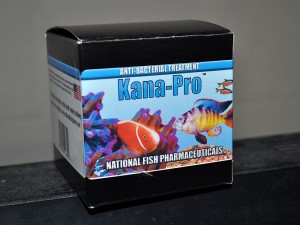
Today, I have to say I’ve not seen any signs of improvement. No, things appear to have gotten worse. Let the pictures speak for themselves:
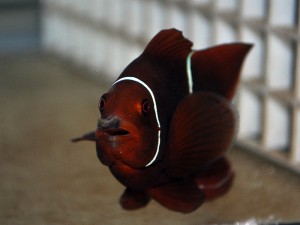
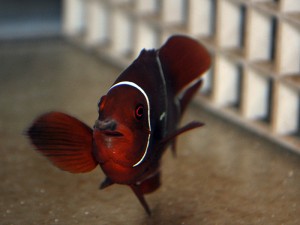
Add on stringy feces, decreased activity, and the possibility of Brooklynella showing up (can’t say yet) and this fish is arguably going downhill fast. Tonight is the 4th of 5 scheduled doses of Kanamycin. I’m going to do it, but if time permits over the next 24 hours I’m going to solicit for opinions and do the researching I can do. Need to turn this fish around, FAST! I have a feeling I’ll be switching medications tomorrow.
So with this latest shipment of PNG Maroons, I now have the following inventory:
1 PNG Lightning Maroon Clownfish, sex indeterminant
1 PNG Morse Code Maroon Clown, sex indeterminant
4 PNG Maroon Clownfish, your typical White Stripe variety, all still at sizes where they should be male or “juvenile”.
1 “Labrador” Maroon Clownfish, a massive fish that could only be treated as a female at this point.
What’s a breeder to do?
Let’s circle back to the two most interesting fish, the “Lightning Maroon” and the “Morse Code” Maroon (I called it a “Dash Slash” or “Dash Hash” but then Jay pointed out the “dots”, so it was a “Dot Dash” and then Morse Code…you get the idea). I do hold the assumption that there is a genetic basis to the Lightning patterning. I’ve elaborated on that prior. I also think that possibly, this “Morse Code” patterning, the random dot or dash, could be indicative of some genetic variation as well…not simply a “misbar”, but the starting point, the most basic example, of what might represent a continuum or range of pattern variation within the Maroon Clownfish. In simple terms…if the Lightning is the equivalent of an “A-Grade Picasso” Percula, then this “Morse Code” Maroon might very well be the “B-Grade” version of the same genetic barring mutation.
You might think I’m “reaching” here, until I ask you to consider that this is in no way the “first” “Morse Code” Maroon Clownfish I’ve seen. No, I think I’ve actually seen at least a dozen of these fish, in multiple venues. At least one commercial breeder has had fish looking just like this “Morse Code” Maroon and offered them for sale. Maroons are known to throw some variation on striping. For example, check out the spotted Maroons from Reef Hot Spot or this other “one of a kind” Maroon Clownfish thread on Manhatten Reefs. This type of “extra barring” and “spotting” apparently isn’t really all that rare of a thing in Maroon Clowns apparently (and corroborated by at least one author…but I can’t find that reference at the moment!)
Pile on the simple fact that this is another “extra barred” Maroon coming out of PNG, where we already know 2 “Lightning Maroons” have come from. If this subtle, small barring variation is genetic, and is a less extreme version of what produced the “Lightning Maroons”, we could have just struck “gold”. With ALL of that said, in the absence of having a second “Lightning” Maroon on hand, this “Morse Code” Maroon just became the most desirable mate I could utilize.
And yes, there’s a catch. I have yet to put these two fish side by side, but I can tell you this. The Lightning Maroon, and the “Morse Code” Maroon, are about the same size. Both are in the “limbo” size where they could either be mature males, or easily become females. Up until now, I’ve treated the Lightning Maroon as if it were male, in the hopes that if it IS in fact male, it could remain male. Again, I’ve elaborated on the “why” before.
But now there’s this other ambiguous fish. If it was notably SMALLER, it would’ve been a no-brainer….pair it with the Lightning, making the Lightning a female. A great pair, and arguably the best I could hope for. But CAN I do this?
It’s hard to say. I have to fight the likihood that BOTH the Lightning Maroon and the “Morse Code” Maroon could be female. Jake Adams already drew the conclusion that the Morse Code was female without even knowing its size…just looking at a picture. So yeah, a fair amount of folks might already call the Morse Code female, and in most other settings, it would be paired up to be the female.
But what if one, or both fish in question, can still be male? Well, as you know, the Lightning Maroon has been treated as male up until this point. The XXLG “Labrador” Maroon from Frank and Mary has been prowling the main tank in the hope that its presence would keep the Lightning male (assuming it IS male). They have not been allowed to interact…this has been a “show of force” more than anything else.
Ideally, while in Quarantine, it would be wise to attempt the same “social pressure application” on the Morse Code Maroon. In other words, try to pair it, or at least house it, next to a much larger Maroon. That way, if it’s male, it will remain male while in QT. And then, when the time comes, it could be paired with the Lightning Maroon.
To accomplish such a pairing, the ideal mechanism would be to allow the Lightning Maroon to pair up with any one of the small PNG Maroons that was shipped in. Of course, we’re looking at at-least a few weeks before the “all clear” siren is blown and that process could start. Get the Morse Code Maroon paired up as well, but as a male. Allow the Lightning to grow substantially in size, and then SWAP out the males, bringing the Morse Code in as the male, and the Lightning as the female.
It all works in theory. But what if the Morse Code is already female? Well, if that happens the best pairing scenario would be to form 2 pairs. A Lighting + PNG pair, and a Morse Code + PNG pair. The practical upshot is that we could attempt a “Lightning X Morse Code” (or if you prefer, an “A Grade Lightning X B-Grade Lightning”) pairing once the NEXT generation is born. It’s a less direct route, but it’s by far the safest route to go.
But what if I’m not fully committed yet to allowing the Lightning Maroon become a female? There is that odd chance that I could continue to apply social pressure to the Lightning Maroon, and could even move forward with highly controlled pairing to the Labrador Maroon. I’d be foregoing the PNG geographic lineage in any offspring that develop. In the meantime, I’d also have to let the Morse Code Maroon grow substantially, and that could take years. And THEN try to pair the Lightning to the Morse Code, putting the Lightning at greater risk acting as the male. As you can see, I’m clearly leaning towards letting the Lightning go female, but I’m probably going to by myself some time and try a few different things.
My ideal plan is to construct a far more permeable yet secure enclosure for the Lightning to allow better interaction with the Labrador Clown. I’ve heard annecdotes of clownfish being able to fertilize spawns through physical barriers. I figure, WHY NOT at least let there be a chance of some reproduction over the next month?
But if I do stay on the path with the Labrador, what do I do to push the Morse Code Maroon in the direction of being male? Well, quite simply, I’ve found myself in need of yet another ridiculously large Maroon Clownfish! I’d pretty much want to do the exact same thing to the Morse Code that I’m doing to the Lightning. Being smaller than the Lightning, there is still a better chance that the Morse Code could remain male.
What if none of this works? Well, there’s a reason I had a standing order for 4 PNG Juvies from Blue Zoo. Quite simply, I could find myself with SEVERAL female Maroons, and I’d like to have mates for them all. If I’m honest, the most likely and safest scenario is to just mate the Lightning to a PNG Juvie, do the same with the Morse Code. If there’s any disasters, I have 2 backup males. If everything works flawlessly, I could pair both “spare” Maroon clowns with little Juvies from PNG, have the Lightning X Morse pair, and 2 extras, just in case. But most likely, I might end up with 4 pairs of Maroons in the long run, at which point I’d probably part with the BIG Maroons so I could focus on 2 PNG pairs.
Yes, that’s a lot of thinking, and I’m a Maroon shy of my plan at the moment. Quarantine buys me time to think this through a bit more, and we’re not out of the woods yet. More on the “Morse Code’s” issues in my next installment.
I’m a unabashed fan of certain things. In line with recent “regulations” regarding “blogs”, “bloggers” are supposed to tell you when they’re talking about something they received gratis from a company. So let me say this up front. My opinion is NEVER for sale. Never.
If I talk about something and say I like it or recommend it, it’s because I like it, and recommend it. In fact – of anything I’ve ever received gratis from anyone in the industry, it has always been from a company that I already appreciated, admired, and spent a fair chunk of change with/on! And to top it off, it’s generally quite rare that I’m offered (or accept) gifts from folks in the industry…it’s not like manufacturers are bending over to give me swag and I’ve always felt there are folks much more deserving than myself!
At any rate, I figured I should tell you a bit about the things I’m a fan of, and why.
Mountain Dew
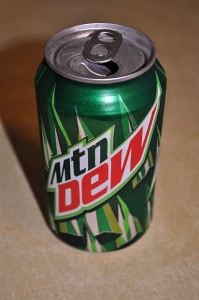
I’m a fan of Mountain Dew because it’s simply delicious. Refreshing and satisfying to my sweet tooth, with all the kick I need. Well, all the kick I needed before I was a father, on your average day, in place of morning coffee. Hey, I’m a software developer. We drink Mountain Dew. It’s an unspoken rule. But when Mt. Dew isn’t cutting it, there’s always…
…Red Bull!
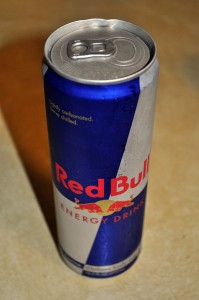
Some of you no doubt think it tastes like CRAP. I love Red Bull. Curiously, I find it far from SWEET, no, to me it’s more like the best ginger ale I’ve ever tasted. And yes, it has kick. LOTS of it. If you are wise you consume it sparingly. This is the heavy duty stuff you break out when you’re getting up at 4:00 AM to go fly fishing or in need of an all night programming marathon. So I’m a fan of Red Bull. Not to mention their inventive ad campaigns, their Flugtag, and their sponsoring Airplane Racing and getting it on TV.
Beer Cozies
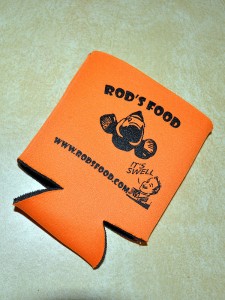
I’m a fan of Beer Cozies. Especially ones that remind you of the rear end of a fish. Given to me by a “fish guy” no less.

They keep my favorite “pick me ups” cool when working in a hot, humid fishroom at 2:00 AM. They also keep their namesake, BEER, cool too.

Yes, I’m a fan of good beer too. 3 of my favorites are shown here, as well as one I drink because it reminds me of my wife. Care to guess which brew #4 is? I’m a fan of beer because it too is refreshing, but in direct opposition to my caffeine-laden life bloods, sometimes a beer is just more appropriate. But this is really a subtopic on beer-cozies.
Besides keeping my beverage of choice cool, the beer cozy pictured is incredibly helpful in deciphering an otherwise chaotic environment. What once was a beverage lost in the shuffle…

…now is a beverage FOUND!
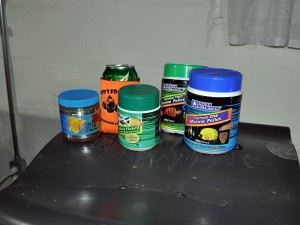
Yes, the right beer cozy makes it easy to find your beverage even in the most extremely visually complex environment…

…and can really help you from grabbing the wrong “drink” in your fishroom fridge.

And there’s much more to be a fan of. Like…
“Blank Canvases”
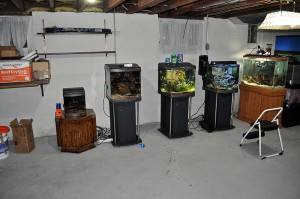
Yes, this is a glimpse into a portion of the current basement fishroom that contains the Lightning Maroon Clownfish (third 24 gallon nanocube, net breeder at left front). Hey, it’s been a crazy 2 months. The tanks at far right are but a few of the 60 or so waiting for the right time.
Still, I can’t help but mention those great orange Beer Cozies in the shot. They were courtesy of….
…fellow marine fish breeder Rod Beuhler!
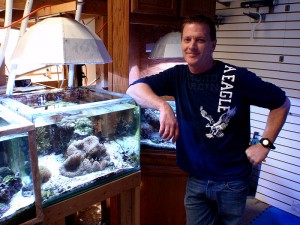
Well, more specifically, Rod Buehler, creator of inventive beer cozies being used in inventive ways to market innovative products. Example?

That’s right – sample packs of “Rod’s Food” in a “Rod’s Food Beer Cozy” to keep your sample from thawing out while you walk around whatever convention or event it is where you just met Rod and got a sample of his SWELL FOOD!
ReefBuilders?
Wait, how does being a fan of Reefbuilders tie into all this? Well, it’s where I recently published a story on the importance of feeding quality food frequently, and how I learned the hard way just how very important high quality food (and frequent feeding) is. What I didn’t mention in that article is the relative “dirth” of “quality foods” here in Duluth MN. If I’m in a pinch, I can find some of the frozen foods I like locally, but *most* frozen foods have to be ordered online in bulk and shipped to me (one of the many reasons I’m a fan of Drs. Foster and Smith Aquatics) I thought I was “golden”, but apparently the only place you can get one of my favorite foods (ah..coming full circle now) is the local fish store?
I begged Rod to sell me his food directly, but since I’m not a shop (and have yet to set up as a formalized hatchery), that goes against the rules (bravo to a man who’s sticking by his business practices!). I used to buy Rod’s food in from my LFS’s in Chicago, but now my closest store is almost 3 hours away (another thing I’m a fan of, Saltwater Empire and Fritz!). So fellow fish breeder Rod sent me a bunch of food and cozies, and my fish are once again eating high quality frozen food (and my favorite beverages / live blood is finally staying COLD in my fishroom).
Of course, I’ve been handing out samples of Rod’s food to my local club members and local stores. I’m hoping I can convince one or two of my local shops to carry Rod’s Food so I don’t have to be an ongoing beggar…afterall, I admit I was a skeptic years back when some local Illinois guy was making food and selling it, but once I finally tried it, I was hooked. “Fish Only Blend” (we don’t need no stinking corals!) is my personal favorite, but I’m intrigued by his new fish eggs pack – I can’t find Fish King eggs anywhere these days, but maybe I can get some of Rod’s brand in the future!
So yes, while I feed a varied diet of high quality foods, one of my personal favorites just came through for me and my fishroom. I’ve seen imitators out there, but strongly suggest you accept no substitutes. If you haven’t tried it yet, you should. It has everything I’d put into food if I was making it myself. It gets a great feeding response. It has “something for everyone” in the tank. I know it’s high quality, and that’s what I NEED as a fish breeder. If it’s good enough to produce “Rod’s Onyx” then it’s certainly good enough for my projects. The Lightning Clownfish (brand new picture!!! – Fan of my wife’s Nikon D5000 too) certainly seems to endorse it…
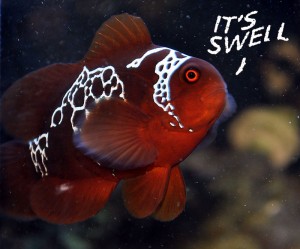
(yes, I am truly thankful and ecstatic for Rod Buehler’s continuing support of my efforts both as a food maker and a fellow clownfish breeder. Rod is one of those fish friends who I’m grateful for because of ALL that they contribute to the hobby…it’s not just a business. I encourage YOU to be a fan of the people and companies who do quality things that impact your own efforts…these are the people that make a difference! And yes, I just found out you can even “like” (formerly become a fan of) Rod’s Food on Facebook!)
So, to Rod Buehler and Rod’s Food, tonight, all of the Maroon Clowns and I raise a cozy to you in a toast of thanks! Since it’s 3:45 AM and Ethan just went to bed, might as well make it a Red Bull in that cozy and pull the all-nighter…
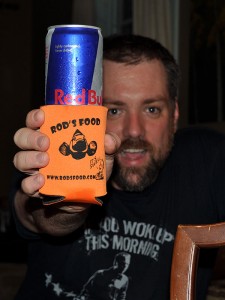
(I’m also a fan of not taking yourself TOO seriously and taking a joke way too far).
Have a great 4th of July holiday for those of you in the United States! Next update, back to the serious business, talking about the PNG Maroons sent to me by Blue Zoo Aquatics from Seasmart (didn’t think I’d even need to mention that I’m a fan of them!)
A big shipment of fish, including PNG Maroon Clownfish from the Papua New Guinea SEASMART program landed on my doorstep the morning of July 1st, 2010. As you likely know, it’s been a bit of a dance to get fish ready for shipment as well as conditions being right to receive a shipment! I’m glad Mark Martin stuck with it, and as usual, it was a great, well packed shipment from Blue Zoo Aquatics.
I had a standing order with Mark for 4 ‘juvies’ and 1 large female. While large females are hard to come by, Mark found something else to send me. Ultimately, I received 5 fresh new PNG Maroons in this shipment. All have gone into regular tanks, not really “QT” parsay….2 share a 10 that’s been empty forever, 2 share a 30+ gallon tank, and 1 is in a breeder net in a 20 long that houses an Allardi and a couple damsels. I have yet another empty tank set up if i need it…but for now, it’s “quarantine” with a “wait and see” approach. As usual, all the new arrivals were temperature acclimated and then drip acclimated.
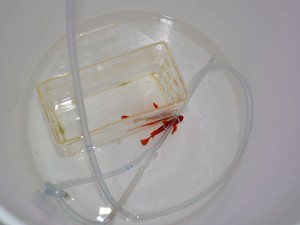
Drip Acclimation of 2 PNG Maroon Clownfish - the specimen cup has holes in it, and is used to keep the fish from killing each other while drip acclimating.
So I had limited time tonight, but I tried to snag some photos of the new arrivals.
So, the 4 small PNG Maroons were easily 1.5″, possibly 2″, and they all pretty much looked like the above. But remember, I said Mark sent me 5 maroons. What was that 5th “surprise” PNG Maroon?
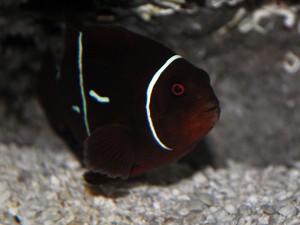

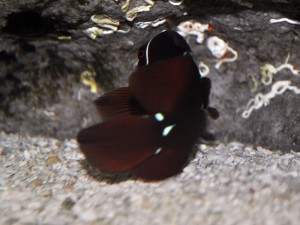
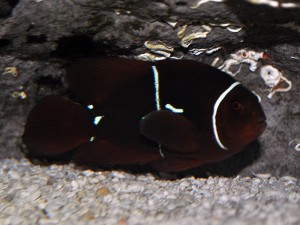

I’m just going to let that “simmer” with you all for a little while. I have my own thoughts that I’ll share soon enough…
It’s been a BUSY day. Possibly will get the post on the cliffhanger done yet tonight, but you might get to wait a few days. We’ll just see…
In the meantime, I tried out Renee’s new Nikon D5000. It shoots video in HD apparently, so I took this one of the Lightning Maroon…enjoy!
So excited. Patience pays off, and I might say things happen for a reason. I will say I’ve been keeping an eye on the PNG SEASMART Program and caught wind of a shipment hitting the states. How would I get such insider information before you?
Well…it’s actually really easy. I’m a friend/fan of SEASMART on FACEBOOK!
If that’s not enough of a hint, let me leave you with one more thought – I have 4 empty quarantine tanks plus breeder nets for a reason… 😉
Tomorrow is going to be a FUN day!
I got news. Good news. No, REALLY good news, possibly GREAT news, from Mark Martin @ Blue Zoo Aquatics via email just a little while ago. I called him to confirm it but had to leave him a voicemail.
I’m certainly not one to count my chickens, but I can’t help but be happy. If all goes well, tomorrow, July 1st, is going to be a great day in The Lightning Project. Talk about a way to end the month! Stay tuned!
Since the PNG Lightning Maroon hit the online world, there’s been over 100+ threads on it. I’m not about to link to them all here, but I found the conversations I had with a few of my fellow TCMAS (Twin Cities Marine Aquarium Society) members very interesting. The original thread is here ( http://www.tcmas.org/forums/showthread.php?t=25958 ), but I’ve summarized my side of things here for easier consumption 🙂
Clint (who helped me fund this project by purchasing some of my fish) posed some really interesting questions.
#1. Why did I start out with a larger female to pair the Lightning Maroon with vs. a smaller fish (to make the Lightning Maroon become female)?
Several people have posed this question and it’s a very valid one. Afterall, pairing the Lightning Maroon with SMALLER fish would minimize the pairing risk, minimizing the chances of death. Still, I had (and still have) several reasons for thinking keeping the Lighting Maroon male (if it is male) is the way to go:
Simple answer – Blue Zoo Aquatics was already sold out of all the smaller PNG juveniles before they even had a chance to set some aside for me, so the only way to go when the Lightning Maroon was shipped was to send me a big female.
More complicated answer – If I could keep the “Lightning Maroon” as a male, there was/is a greater chance of a quicker spawn by trying to pair it with a female vs. waiting for a sex change to occur. Additionally, since Maroons, most notably LARGE FEMALES, tend to lose their stripes as they age, better to keep this guy as a male so the awesome lightning bolts stay!
Really complicated answer – If SEASMART were to find a second Lightning Maroon, and IF I were to obtain it, I would have much greater chances of pairing “Lightning” with “Lightning” if the first Lightning Maroon remains male. If the Lightning Maroon is allowed to become female, and a future discovered Lightning Maroon is also female, I won’t be able to pair them. So, pairing possibility drops by at least 50% if I allow the first Lightning Maroon Clownfish to become a female.
Hearsay answer – there has been talk that “male” clownfish have more influence on “patterning”, whereas females have more influence on “coloration”. I think that’s bunk, but at the same chance, I’m not going to dismiss it outright.
#2. Is there any evidence to show that the pattern is a dominant or ressesive gene carried by the male?
My initial answer is that genetically we can speculate anything we want. We are even speculating that the Lightning morph has a genetic basis in the first place. It may not be a genetic trait. We may never see another Lightning Maroon Clownfish even if I do everything perfectly.
#3. To paraphrase Clint’s third question, he asked if there was any difference in the likelihood that Male Lightning X Female Regular = more Lightnings vs. the flipside, Male Regular X Female Lighthing = more Lightnings.
My Response: There are a number of things to remember about clowns, starting with the fact that they’re all born male, and the dominant one turns female. Any male can later become a female.
A rough genetic picture might be to look at a straight up recessive trait like albinism for a comparison. LL = Lightning. LN or NN = Normal fish. Thus, the Lighting Clown being LL, mated with a normally colored NN fish, will produce only LN offspring. No lightnings in the first generation (F1). Mating those offspring together would produce LL, LN and NN fish, at a 25%, 50%, 25% rate. So 25% Lightnings, 75% normally colored, with 2/3 of the fish carrying the recessive L.
However, a LL fish, mated with an LN fish, will produce 50% LL and 50% LN right off the bat. Given that there have been other “Lightning Maroons” seen in PNG, including the other one collected in 2008, the chance of this being a “possibility” is partially why it is so critical to select mates from PNG, ideally the same reef. It increases the chances that the normally colored mate may in fact be LN. Just as easily could be NN, and probably more likely is, but you cannot tell if the trait is recessive.
I think if the trait was dominant, we’d see many more Lightning Maroons out there.
Now, here’s the reality. Even if this genetic, it may not be a simple straight up recessive trait. It could be something like Platinums and Picassos, where there may be more going on. Based on the breeding outcomes of Picasso Percula offspring as reported by David Durr and Tal Sweet, the “Platinum” and “Picasso” genetic mix is starting to look like the following:
Platinums = PP. Picassos may be PN. Normal Percs might be NN.
Again, that is PURELY SPECULATION. It could actually turn out that Platinums = PPP, Picassos are PPN or PNN (A and B Grade anyone) and Normals are NNN. Or something different. We don’t know enough yet. Good observation and careful records, along with SHARING OF DATA, will be what reveals the truth.
#4. TCMAS member “lr9788” then asked, “How does breeding continue down the line? Since this is a one of a kind doesn’t it present genetic issues? Or can a lighting be paired with any maroon (in theory)?”
This question inspired a very long response! So here it is, largely unedited, and I’ll let that wrap up this first post on “Genetics”, elaborating a bit on the thought process behind how I’m approaching the breeding of this fish.
Well, truthfully there are not any concerns about line breeding, generally in fish, until about the F6 generation. The parents here (Lightning PNG X Reg PNG) are F0. Their offspring are F1. I assume F1 will all be normal. Pairings of the F1 Offspring will produce F2, and it is there that we might first see Lightnings (of course, I could be wrong and we could see them in F1, but heck, we don’t even know if this is genetic yet!).
So, lets say you get F2’s that are Lightnings. It is here that we could first see “Lighting X Lightning” crosses. All are still PNG maroons as well at that point, having descended from the original PNG-collected normal & lightning pair. It is possible/likely/probably that the matings of F2 X F2 lightings would yield a much higher number of Lightning Offspring in that F3 generation.
Now, since Clownfish can be productive spawners for 10-20 years easily, we need to realize that we could work with F2 Lighting X Lightning crosses to produce all the Lightning Maroons needed for a long time. Why?
Well, let’s say we get this pair spawning in a year or two. So 2012-ish. Their F1 offspring could be spawning as early as 2014 perhaps? Which means the first F2 offspring were we likely see Lightning Maroons in quantity (if it all works) would be maybe in 2015. Any pairing that starts throwing lightnings could continue to do so for the next 10-20 years (so let’s say 2035 is when they start dying off). However, we could realistically continue to create new F1 pairs that *might* throw F2 lightnings for another 5-10 years with the initial offspring of the wild parents. So that means, time wise, we could have F1 generation fish still producing F2 offspring in 2040.
If we take another 2 years to get those first Lightning X Lightning crosses spawning, that puts us at maybe 2017 for their F3 generation. Again, conservatively we could go 10-20 years from the point this generation STARTS, so 2027 to 2037 easily. But again, same math for the F1’s that throw out Lightnings as F2. Based on that RANGE, knowing we could still get F2 Lightnings at 2040, means realistically we could still be producing line bred F3 Lightnings at 2050 or even 2060.
And we’re only at the F3 generation in line breeding which yes, is inbreeding. But remember, the general rule is that we can go to around F6 before we start seeing genetic problems as a result of this inbreeding in fish. So realistically, given the LONG reproductive lifespan of Clownfish, we could easily be into 2100 before we really have to worry about hitting that F6 generation.
The reality is that there are several other items at play. There may be more WC lightnings brought in…we certainly see that happen with Picasso Percs. That would open up all sorts of outcross possibilities.
Even if another Lightning never makes it into captivity, the reality is that we know these are PNG Maroons. Knowing the methodology that fixes the Lightning Strain, we could easily then take and outcross to other PNG Maroons to infuse new genetics and then go through the selective process again. So, long term, with either one crazy dedicated breeder, or the cooperative work of several, we could find ourselves with only semi-related Lighting Maroons. Pile on the simple fact that we are talking about mounds of sexual reproduction (and the inherent genetic variation that can occur), and the reality is that fairly quickly we could have a solid captive population that has descended from a tiny handful of seed stock from the wild.
Beyond THAT, it is also quite likely that the breeding of Lightning Maroons might leave the confines of only Maroons from Papua New Guinea (PNG). I think this is a big mistake, but I already know it will happen. People will take Lightning Maroons and cross them with Gold Stripe Maroons in the hopes of making Gold Striped Lightning Maroons. They’ll mate them with other abberant Maroon Clownfish varieties that show up (i.e. there are gray-barred Maroons..which honestly I kinda like). In the long run, this is where the guppification happens and we get into captive-produced varieties. This is what I don’t like, but know will happen. And yes, I will have played a part in it.
But for me, it’s about keeping the PNG location intact. Even if these fish never turn out another Lightning, we know that they were PNG collected and represent the genetics (and whatever distinct minute difference there may be) of Maroon Clownfish from PNG. To me, this is important. This is why I own “Sumatran” Fire Clowns and “Vanuatu” Pink Skunks (which also happen to carry that nice Orange “sunkist” color variation). I.e. on the Skunks, the color variant is a nice wild coloration, but who knows if it carries on to the offspring. Thankfully, the value for me comes first in knowing that they’re Vanuatu Pink Skunks vs. Fiji Pink Skunks…the fact that they have the more orange-yellow coloration is an interesting side benefit.
And finally, I’d like to simply take the question of Genetics and cite the recent article in CORAL magazine by Ret Talbot.
Ret put the question of genetics to two of the Marine Fish Breeding community’s premier experts, Martin Moe and Matthew Wittenrich. Bottom line, you should read the whole article (starts on page 8 of the May/June 2010 issue of CORAL). But I’ll tell you, it’s a 50/50 split as to whether the Lightning Maroon represents a genetic variation or not. I’ll let you go find out which person held which stance!
So first off, yes, the Lightning Maroon Clownfish is still alive and healthy and living in its Bubble Tip Anemones. It remains still inside a breeder net, with the large “Labrador” Maroon clown from Frank and Mary lurking outside. The net has become overgrown with algae, so I am currently thinking of making a “cage” out of egg crate to allow for better interaction between this smaller maroon and the larger one. I have heard of fish being able to fertilize nest that are laid even when divided with egg crate…who knows….maybe the Lab and the Lightning will do their thing while we’re waiting…
And yes, I am still waiting for some PNG Maroon mates! Not sure what the story is right now. Last I heard fish were on hold for me, but it’s been a while. I suppose I should make a phone call to my friends @ Blue Zoo!
For those of you who’ve been asking for HD Video, your wait may soon come to an end. While all three of my good cameras remain in states of disrepair, we got my wife a new Nikon DSLR for her birthday. It supposedly also takes HD Video. I’ll have to give it a whirl!
I thought, in the absence of any real news, I might repost some thoughts I had on the genetics of this fish and how I’m going to approach things. They’ll come in a subsequent blog post either today or in a couple days.
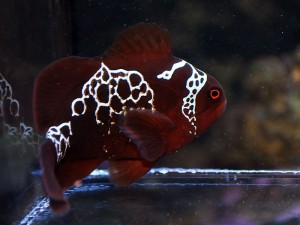



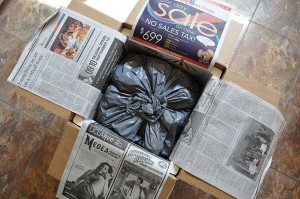

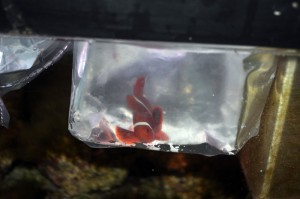
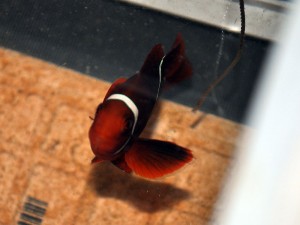
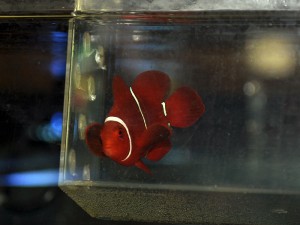
Recent Comments